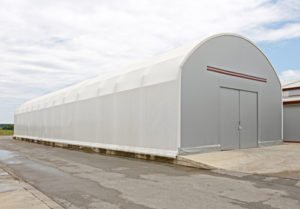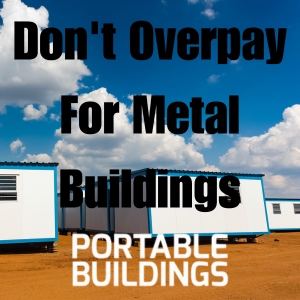
Seasonal Storage Solutions for Retail Businesses
In the dynamic world of retail, managing inventory effectively is pivotal to success. Retail businesses, especially those with seasonal product lines, face the unique challenge of balancing excess stock during peak seasons and minimizing unused storage space during off-peak times.
Portable Warehouses: The Seasonal Storage Solution
Traditional storage solutions often fall short in providing the flexibility and cost-effectiveness required to navigate these seasonal fluctuations. This is where portable warehouses emerge as a game-changer. Offering unparalleled versatility, these movable storage units are tailor-made to meet the ebb and flow of retail storage demands, making them an indispensable tool for retailers aiming to optimize their inventory management strategies.
This blog delves into the world of portable warehouses, showcasing why they stand out as an excellent option for retail businesses, detailing their cost implications, and highlighting the potential savings they offer. As we explore this innovative solution, retailers will discover how portable warehouses can not only address their seasonal storage woes but also contribute to their overall operational efficiency and profitability.

Understanding Seasonal Storage Needs of Retail Businesses
The Cycle of Seasonal Inventory
Seasonal inventory management is a balancing act that retail businesses must master. During peak seasons, such as holidays or summer sales, retailers often stock up on additional merchandise to meet the surge in consumer demand. However, once the season tapers off, the leftover inventory can become a costly burden, occupying valuable space and tying up resources. This cyclical pattern necessitates a storage solution that can adapt to the fluctuating inventory levels without incurring excessive costs or waste.
The Crucial Role of Flexible Storage Solutions
The ability to swiftly scale storage capacity up or down in response to seasonal demands is crucial for maintaining operational efficiency and financial health. Traditional fixed storage facilities offer limited flexibility, often leading retailers to lease additional external spaces or struggle with overcrowded storerooms. These challenges not only lead to increased operational costs but also hamper the agility of a retail business to respond to market trends effectively. Flexible storage solutions, such as portable warehouses, allow retailers to navigate these seasonal changes seamlessly, ensuring that the right amount of inventory is stored safely and accessibly, exactly when and where it’s needed.

Benefits of Portable Warehouses for Retail Businesses
Scalability
One of the most significant advantages of portable warehouses is their scalability. Retailers can easily add or remove units based on their current storage requirements, ensuring that space is never wasted on storing air during low seasons, nor is it insufficient during peak times. This adaptability is critical for maintaining lean operations and optimizing inventory costs.
Cost-Effectiveness
When compared to traditional warehousing options, portable warehouses present a cost-effective solution for seasonal storage needs. The expenses associated with permanent structures, such as property taxes, long-term leases, and maintenance, can be prohibitive. Portable warehouses, on the other hand, can be rented or purchased based on short-term needs, offering a flexible financial commitment that aligns with the retailer’s budget and storage requirements.
Mobility
The ability to relocate storage facilities as needed is another compelling benefit of portable warehouses. Whether moving inventory closer to a key market for faster distribution or repurposing space for different uses, the mobility of portable warehouses provides retail businesses with operational agility. This flexibility can be particularly advantageous during unexpected market shifts or when testing new products in different locations.
Speed of Deployment
Time is of the essence in the retail sector, and the quick setup times of portable warehouses are a critical advantage. Unlike permanent structures that may require months of planning, permits, and construction, portable warehouses can be deployed rapidly, ensuring that retailers can respond swiftly to storage needs as they arise.
Cost Analysis of Portable Warehouses
Navigating the financial aspects of portable warehouses is essential for retailers considering this storage solution. A comprehensive cost analysis reveals not only the upfront investment but also the long-term savings potential, making it clear why portable warehouses are a financially sound choice for seasonal storage needs.
Initial Investment vs. Long-term Savings
The initial cost of acquiring a portable warehouse can vary widely depending on size, features, and whether the unit is purchased or rented. While purchasing a portable warehouse requires a higher upfront investment, it eliminates recurring rental fees, offering long-term savings for businesses with ongoing storage needs. Conversely, renting provides flexibility and minimal initial costs, suitable for retailers with fluctuating or short-term requirements. Despite the initial outlay, the return on investment becomes apparent through reduced dependency on external storage facilities, avoidance of long-term lease commitments, and lower overall storage costs.

Breakdown of Costs
- Purchase: The one-time purchase price of a portable warehouse can range significantly based on customization, materials, and size. However, this option eliminates ongoing rental costs and provides asset ownership.
- Rental: Rental options offer flexibility with lower upfront costs. Monthly rental fees are predictable expenses that can be easily adjusted according to the business’s storage needs.
- Maintenance and Operation: While generally low, maintenance and operational costs for portable warehouses include basic upkeep, utilities (if applicable), and insurance. These costs are often significantly lower than those associated with permanent warehousing.
Many retail businesses have documented substantial cost savings after transitioning to portable warehouses. For instance, a seasonal clothing retailer reduced its storage costs by 40% by switching from leased external storage units to owned portable warehouses, recouping its initial investment within two years. Another example involves a holiday decorations retailer that leverages portable warehouses to manage its highly seasonal inventory, avoiding the high costs of year-round leases on underutilized space.
Implementing Portable Warehouses in Retail
For retail businesses ready to embrace the flexibility and cost-effectiveness of portable warehouses, implementing this solution involves several key steps. From choosing the right provider to maximizing storage efficiency, the following considerations ensure a smooth integration of portable warehouses into the retail operation.
Choosing the Right Portable Warehouse Provider
- Reputation and Reliability: Look for providers with a strong track record and positive customer reviews.
- Customization Options: Ensure the provider offers the customization needed to meet your specific storage requirements.
- Support and Service: Consider the level of customer support, including installation assistance and maintenance services.

Considerations for Site Preparation and Installation
- Location: Choose a site that maximizes logistical efficiency, ensuring easy access for loading and unloading.
- Foundation and Anchoring: Depending on the duration of use and local regulations, prepare a suitable foundation and secure the warehouse properly.
- Utilities and Security: If needed, plan for utilities (e.g., lighting, heating) and implement security measures to protect your inventory.
Best Practices for Maximizing Storage Efficiency and Security
- Inventory Management: Utilize shelving and organizational tools to maximize space and maintain an accurate inventory.
- Climate Control: For sensitive items, consider portable warehouses with climate control options to protect against temperature and humidity.
- Access Control: Implement measures to control access, such as secure locks and surveillance cameras, to safeguard against theft and vandalism.
Portable warehouses present a compelling solution for retail businesses grappling with the challenges of seasonal storage. By offering scalability, cost-effectiveness, mobility, and speed of deployment, these versatile structures provide retailers with the flexibility needed to optimize their inventory management strategies. The financial analysis further underscores the potential for significant cost savings, making portable warehouses not just a storage solution but a strategic investment toward greater operational efficiency and profitability.
As the retail landscape continues to evolve, embracing innovative solutions like portable warehouses can be a game-changer, enabling businesses to stay agile and responsive to market demands. By carefully considering the implementation steps and best practices outlined, retailers can effectively integrate portable warehouses into their operations, reaping the benefits of this adaptable and cost-efficient storage option.


